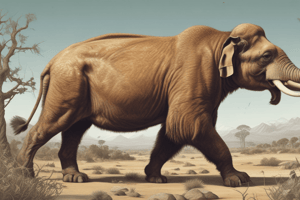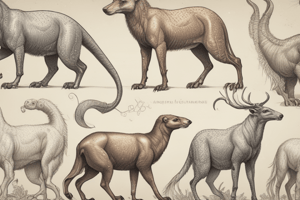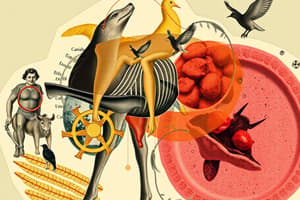Podcast
Questions and Answers
What is a characteristic that is unique to mammals?
What is a characteristic that is unique to mammals?
- Three middle ear bones (correct)
- Scaly skin
- Cold-bloodedness
- Gill respiration
Which subclass of mammals includes placental mammals and marsupials?
Which subclass of mammals includes placental mammals and marsupials?
- Eutheria
- Prototheria
- Theria (correct)
- Metatheria
What is the term for the development of limbs in mammals?
What is the term for the development of limbs in mammals?
- Neoteny
- Evolutionary adaptation (correct)
- Hybridization
- Dietary specialization
Which part of the nervous system includes the brain and spinal cord?
Which part of the nervous system includes the brain and spinal cord?
What is the term for the milk-producing glands in female mammals?
What is the term for the milk-producing glands in female mammals?
Which type of mammal is characterized by giving birth to undeveloped young that complete their development inside a pouch?
Which type of mammal is characterized by giving birth to undeveloped young that complete their development inside a pouch?
What is the term for the process by which mammals regulate their own body temperature?
What is the term for the process by which mammals regulate their own body temperature?
Study Notes
Mammals
Characteristics:
- Warm-blooded (endothermic)
- Hair or fur
- Mammary glands for milk production
- Three middle ear bones (ossicles)
- Live birth (viviparity)
- Brain development: neocortex, cerebrum, and cerebellum
Subclasses:
- Prototheria: monotremes (egg-laying mammals)
- Examples: platypus, echidna
- Theria: placental mammals and marsupials
- Metatheria: marsupials (pouched mammals)
- Examples: kangaroo, koala, opossum
- Eutheria: placental mammals
- Examples: humans, primates, rodents, carnivores
- Metatheria: marsupials (pouched mammals)
Body Structure:
- Skeletal System: diaphragm, sternum, and pelvis
- Muscular System: voluntary and involuntary muscles
- Nervous System: central nervous system (CNS) and peripheral nervous system (PNS)
Diversification:
- Evolutionary Adaptations: development of limbs, adaptation to environments (e.g., aquatic, terrestrial, aerial)
- Dietary Specializations: herbivory, carnivory, omnivory, and insectivory
Examples of Mammals:
- Primates: humans, chimpanzees, gorillas
- Carnivores: lions, tigers, bears
- Ungulates: horses, cows, pigs
- Rodents: mice, rats, squirrels
- Marine mammals: whales, dolphins, seals
Mammals
Characteristics
- Mammals are warm-blooded, meaning they regulate their own body temperature
- They have hair or fur, which helps to regulate body temperature and protect their skin
- Mammary glands are present in females, producing milk for their young
- Three middle ear bones (ossicles) are present, enabling them to hear more effectively
- Mammals give birth to live young, as opposed to laying eggs
- They have a highly developed brain, consisting of the neocortex, cerebrum, and cerebellum
Classification
Prototheria
- This subclass consists of monotremes, which are mammals that lay eggs
- Examples include platypus and echidna
Theria
- This subclass includes placental mammals and marsupials
- Metatheria: marsupials, which are pouched mammals
- Examples include kangaroo, koala, and opossum
- Eutheria: placental mammals
- Examples include humans, primates, rodents, and carnivores
Body Structure
- The skeletal system consists of a diaphragm, sternum, and pelvis
- The muscular system includes both voluntary and involuntary muscles
- The nervous system is divided into the central nervous system (CNS) and peripheral nervous system (PNS)
Diversification
- Mammals have evolved various adaptations to their environments, such as the development of limbs and specializations for aquatic, terrestrial, and aerial habitats
- They have also developed diverse diets, including herbivory, carnivory, omnivory, and insectivory
Examples of Mammals
- Primates include humans, chimpanzees, and gorillas
- Carnivores include lions, tigers, and bears
- Ungulates include horses, cows, and pigs
- Rodents include mice, rats, and squirrels
- Marine mammals include whales, dolphins, and seals
Studying That Suits You
Use AI to generate personalized quizzes and flashcards to suit your learning preferences.
Description
Learn about the key characteristics of mammals, including being warm-blooded and having hair or fur, as well as their subclasses such as monotremes, marsupials, and placental mammals. This quiz covers the basics of mammalian biology.




